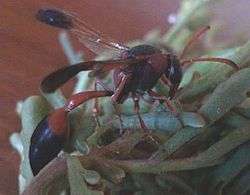Delta dimidiatipenne
| Delta dimidiatipenne | |
|---|---|
 | |
| Scientific classification | |
| Kingdom: | Animalia |
| Phylum: | Arthropoda |
| Class: | Insecta |
| Order: | Hymenoptera |
| Family: | Vespidae |
| Subfamily: | Eumeninae |
| Genus: | Delta |
| Species: | D. dimidiatipenne |
| Binomial name | |
| Delta dimidiatipenne Saussure, 1852 | |
| Synonyms | |
|
Eumenes transcaspicus .[1] | |
Delta dimidiatipenne is a species of Potter wasp from the warmer regions of the Palearctic which specialises in the hunting of caterpillars and is therefore sometimes known as the caterpillar hunting wasp. Another name it is known by is the red potter wasp.[2]
Description
Delta dimidiatipenne has a dull reddish head, with black markings which extend from behind the eyes over the top of its head to the back of the neck. The thorax is mainly black, apart for red patches on the second segment and on the upper parts of the third and last segments (2). A narrow "waist", typical of this type of solitary wasp is created by the fusing together of the thorax and the first segment of the abdomen. The abdomen is mostly black, except for a red band just beyond the waist. The wings are rusty-coloured with grey-brown tips, and may show a purplish tinge. The antennae normally have black tips.
The sexes are similar but the male is slightly smaller and slenderer with a yellow face
The male caterpillar hunting wasp is similar in appearance to the female, although it is slightly smaller and more slender, with a yellow face. Females measure 24-27mm, in length, males 22-25mm.[2]

Biology
Potter wasps are so named for their characteristic nest building behaviour. The nest is contracted by the female from sand or mud which is mixed with saliva in the wasp's jaws to form a wet clay. The wasp then creates pellets of this material by dribbling the wet clay from its mouthparts on to the nest to mould a small pot shaped vessel. The nest is placed on walls or rocks, usually hanging downwards, with a slight lip over the entrance, and the clay dries out and hardens.
When the nest is completed, the female lays a single egg inside the chamber and suspends it from the roof by a thread of silk. She then provisions the nest with several caterpillars, which are consumed by the grub during its development inside the chamber. The adults, like other solitary wasps, feed on nectar, including the flowers of Acacia .[3]
Distribution
Delta dimidiatipenne is a widespread species which extends from Morocco through north Africa to Egypt and Somalia, throughout the Middle East, and east to India and Nepal. It is a recent colonist to the Canary Islands but it is now widespread in the archipelago.
Habitat
Delta dimidiatipenne is regarded as a desert species but can be seen in gardens .[3]
References
- ↑ "Catalogue of Life : 2009 Annual Checklist : Delta dimidiatipenne (Saussure, 1852)". catalogueoflife.org.
- 1 2 "Caterpillar hunting wasp videos, photos and facts - Delta dimidiatipenne - ARKive". arkive.org.
- 1 2 "Emirates Natural History Group > Home" (PDF). enhg.org.